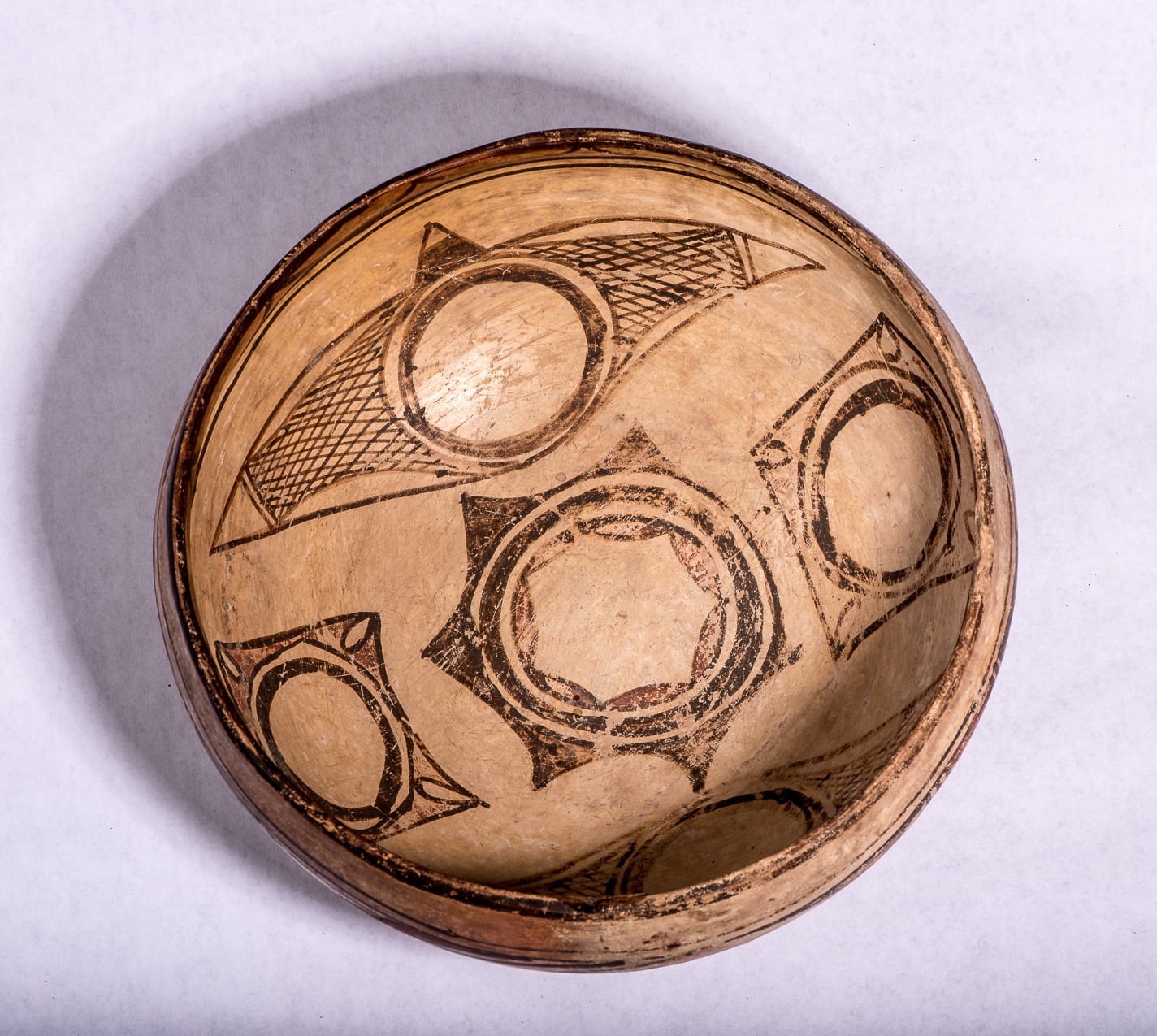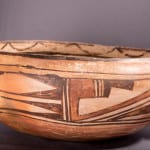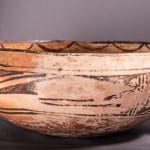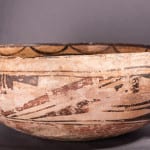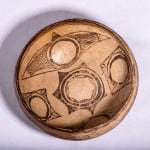This is a thick, solid bowl with a rim that incurves about one-fifth of an inch. Without penetrating to the interior, a 1-inch chunk has been knocked off one side, revealing coarse grey/pink clay that forms the body of the vessel. The bowl is covered with a white slip that may have been stone-polished since it has not crackled. (Uncrackled, stone-polished white slip was known in the 1890’s, but was finer and brighter than the slip on bowl 2014-06. See Wade and Cooke, 2012: 131 and 142-143.) The bottom 1.5 inches of the exterior of bowl 2014-06 is rag wiped with a thin red slip with the white under-slip showing through in places. The bowl carries catalog number 1979.86 (1.1) XH written on the bottom, reference unknown. For reasons detailed below, I type this jar as Polacca Polychrome C and date it 1860 to 1890.
The only good sources I know of information about Hopi Polacca ware are two publications by Edwin Wade and Lea McChesney (1980 and 1981) both based on the Thomas Keam Collection at the Peabody Museum of Harvard University. Two characteristics of bowl 2014-06 seem to be at variance with these authors’ expectation.
Wade and McChesney write “the commercialization of Hopi ceramics began during the Style C period, sometime in the 1880s…(Since these vessels were meant for sale and not home use) many of the vessels in the Keam Collection show no indication of use (1981:143).” Bowl 2014-06 is not so pristine. Both the interior and exterior designs are scratched and worn. Some of the outside panels of decoration are almost obliterated; the red on the base shows similar wear. Unlike many of the pots in the Keam Collection, this bowl seems to have had a long history of indigenous use.
Second, Wade and McChesney write that the typical slip of the period is a “Heavy matte kaolin
slip that crazes. (The) slip appears to have been carelessly rag-wiped and polished. The red underbelly slip varies in thickness and is texturally coarse (1981:143).” The red underbelly paint on bowl 2014-06 seems to fit these expectations, but the kaolin white slip that covers the interior and remaining external surface does not. As noted above, the white slip on this bowl seems to have been stone polished and thus adheres tightly to the surface of the bowl and has not formed the expected crackleture. I’m not sure what to make of this finish. Given its size, wear pattern and slightly incurved rim, perhaps this bowl was used as a piki or pisole bowl and the slip was stone polished so the kaolin clay did not flake off into the food. Unlike piki bowl 2009-17, there is no food residue on the bowl, so such an explanation for the smooth finish is just conjecture on my part.
While no bowl in the Keam Collections seems to have exactly the decorative motifs of bowl 2014-06,
the design elements on this bowl are fairly common among Polacca C bowls in the Collection. Photographs of the Keam pottery are small (about 3” X 1.5”), are black and white, and are printed on ordinary paper, so my view of these pots is limited. Nevertheless Keam bowl #1140 (Wade and McChesney, 1981:213 and 287) seems to have an external painted motif that is very close to bowl 2014-06. On both bowls a crook fits into a triangular space. To its left there are vertical dividing lines and then several black-pointed elements extending into a blank surface, thus creating a “background reversal” effect. The same external design is used on bowls Keam #1268 and #1175 in the collection (Wade and McChesney, 1981: 286, and 272) and others.
Three motifs are painted on the interior of bowl 2014-06. The first is a variation of the Zuni rain bird design, here taking the form of a circle with triangular “wings” extending to the side. The center of these triangular spaces are filled with crosshatching, leaving only a small area at the tip and on the sides unpainted. No pot in the Keam collection contains exactly this design, but Keam bowls #1140 and #115 are close, though they lack the internal crosshatching (Wade and McChesney, 1981: 213).
The second motif on the interior of bowl 2014-06 is a square with thin-over-thick circles in the center. Sprouting from each inside corner of the square are leaf-like lozenges. The area inside the box but outside the circles and lozenges was painted red, but this color is largely worn off. A design similar to this, but lacking the central circles is found in the Kean Collection (pot #1067) but the design is not common (Wade and McChesney, 1981:319).
The two interior motifs already discussed are drawn on the four quadrants inside bowl 2014-06, each design drawn twice. Similar motifs face each other across the bowl’s center. In the center is a third design with a gear-like outer rim with 7 or 5 triangular teeth. (Images of perhaps two of these teeth have largely worn off, leaving the count uncertain.) Inside this outer design is a thick black ring
with thin unpainted areas surrounding it and separating it from other elements. At the center of the design is a final ring of red lozenges. Very similar designs appear on at least two Keam pots, #1220 and #1467 (Wade and McChesney, 1981: 225). Somewhat simpler renditions are found on Kean pot #1072 (Wade and McChesney, 1981:223) and Keam pot #1662 (Wade and McChesney, 1980:84).
Given the similarities between bowl 2014-06 in this collection and similar examples of design on pots in the Keam Collection, I conclude that bowl 2014-06 is Polacca C ware, ca 1860 to 1890. I believe the bowl was indigenously used and am unclear why its white Kaolin slip does not have the typical crackled surface.

